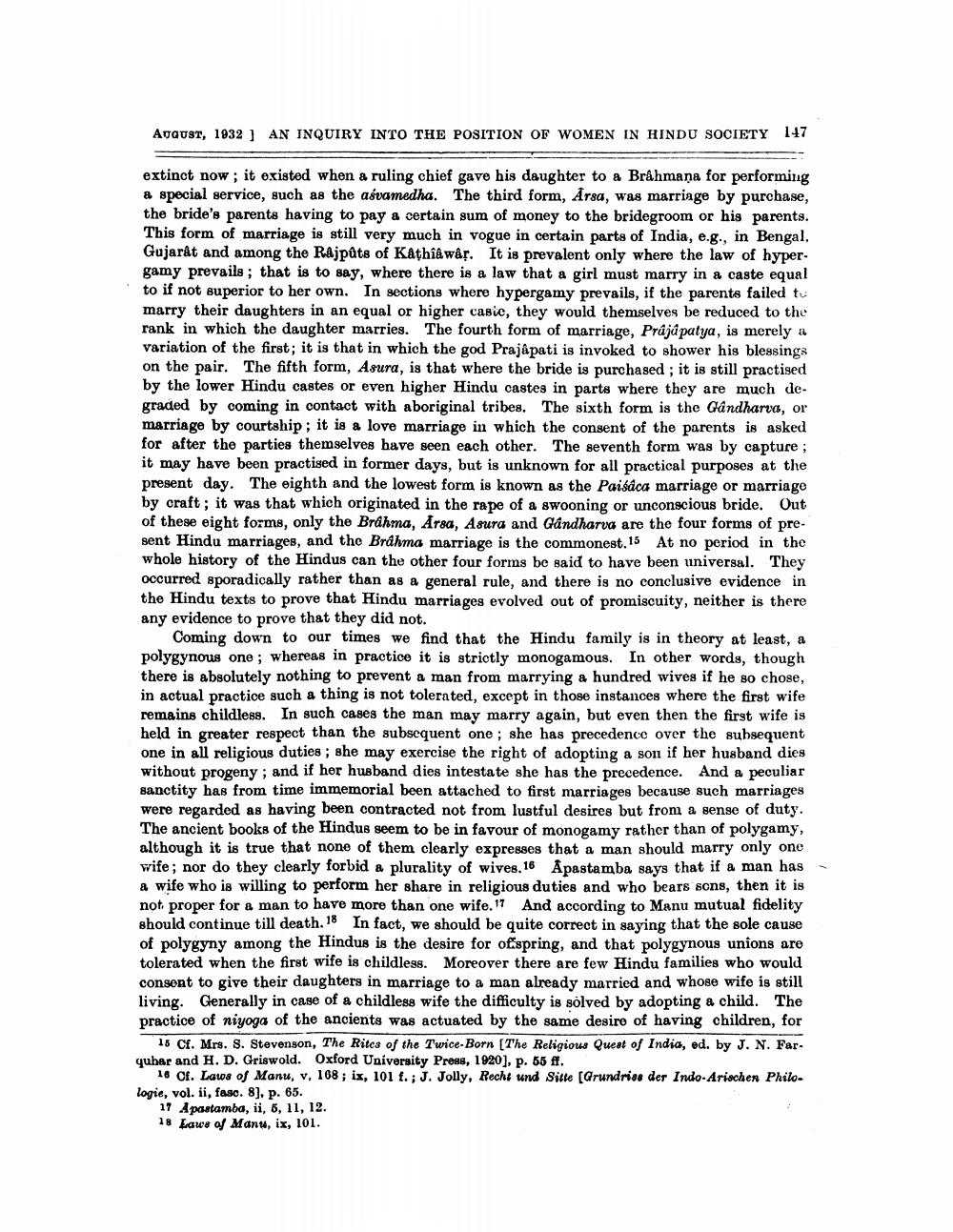________________
August, 1932] AN INQUIRY INTO THE POSITION OF WOMEN IN HINDU SOCIETY 147
extinct now; it existed when a ruling chief gave his daughter to a Brahmana for performing a special service, such as the asvamedha. The third form, Arsa, was marriage by purchase, the bride's parents having to pay a certain sum of money to the bridegroom or his parents. This form of marriage is still very much in vogue in certain parts of India, e.g., in Bengal, Gujarat and among the Rajputs of Kathiâwâr. It is prevalent only where the law of hypergamy prevails; that is to say, where there is a law that a girl must marry in a caste equal to if not superior to her own. In sections where hypergamy prevails, if the parents failed tu marry their daughters in an equal or higher casie, they would themselves be reduced to the rank in which the daughter marries. The fourth form of marriage, Průjá patya, is merely a variation of the first; it is that in which the god Prajapati is invoked to shower his blessings on the pair. The fifth form, Asura, is that where the bride is purchased; it is still practised by the lower Hindu castes or even higher Hindu castes in parts where they are much degraded by coming in contact with aboriginal tribes. The sixth form is the Gandharvas, or marriage by courtship; it is a love marriage in which the consent of the parents is asked for after the parties themselves have seen each other. The seventh form was by capture; it may have been practised in former days, but is unknown for all practical purposes at the present day. The eighth and the lowest form is known as the Paisdca marriage or marriage by craft; it was that which originated in the rape of a swooning or unconscious bride. Out of these eight forms, only the Brahma, Arsa, Asura and Gandharva are the four forms of present Hindu marriages, and the Brahma marriage is the commonest.15 At no period in the whole history of the Hindus can the other four forms be said to have been universal. They occurred sporadically rather than as a general rule, and there is no conclusive evidence in the Hindu texts to prove that Hindu marriages evolved out of promiscuity, neither is there any evidence to prove that they did not.
Coming down to our times we find that the Hindu family is in theory at least, a polygynous one; whereas in practice it is strictly monogamous. In other words, though there is absolutely nothing to prevent a man from marrying a hundred wives if he so chose, in actual practice such a thing is not tolerated, except in those instances where the first wife remains childless. In such cases the man may marry again, but even then the first wife is held in greater respect than the subsequent one; she has precedence over the subsequent one in all religious duties; she may exercise the right of adopting a son if her husband dies without progeny; and if her husband dies intestate she has the precedence. And a peculiar sanctity has from time immemorial been attached to first marriages because such marriages were regarded as having been contracted not from lustful desires but from a sense of duty. The ancient books of the Hindus seem to be in favour of monogamy rather than of polygamy, although it is true that none of them clearly expresses that a man should marry only one wife; nor do they clearly forbid a plurality of wives. 16 Apastamba says that if a man has a wife who is willing to perform her share in religious duties and who bears sons, then it is not proper for a man to have more than one wife.17 And according to Manu mutual fidelity should continue till death. 18 In fact, we should be quite correct in saying that the sole cause of polygyny among the Hindus is the desire for offspring, and that polygynous unions are tolerated when the first wife is childless. Moreover there are few Hindu families who would consent to give their daughters in marriage to a man already married and whose wife is still living. Generally in case of a childless wife the difficulty is solved by adopting a child. The practice of niyoga of the ancients was actuated by the same desire of having children, for
18 Cf. Mrs. S. Stevenson, The Rites of the Twice-Born (The Religious Quest of India, ed. by J. N. Far. quhar and H. D. Griswold. Oxford University Press, 1920), p. 55 ff.
16 Of. Laws of Manu, v, 108 ; ix, 101 4.; J. Jolly, Recht und Sitte (Grundriss der Indo-Arischen Philologie, vol. ii, fasc. 8). p. 65.
17 A pastamba, ii, 6, 11, 12 18 Laws of Mant, ix, 101.




